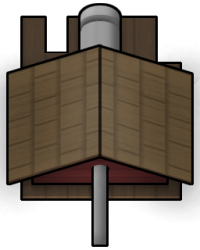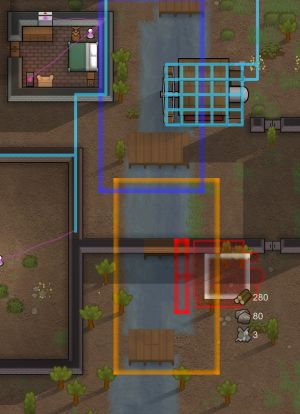Difference between revisions of "Watermill generator"
(reformat) |
|||
| Line 25: | Line 25: | ||
|resource 3 = Component | |resource 3 = Component | ||
|resource 3 amount = 3 | |resource 3 amount = 3 | ||
| − | }} | + | }} |
| + | '''Watermill generators''' are built on moving water to generate constant [[power]], regardless of weather or other conditions. | ||
==Acquisition== | ==Acquisition== | ||
Watermill generators can be constructed once the [[Research#{{P|Required Research}}|{{P|Required Research}}]] research project has been completed. They require {{Required Resources}}, {{Ticks|{{P|Work To Make}}}} of work, and a [[{{P|Skill 1}}]] skill of {{P|Skill 1 Level}}. | Watermill generators can be constructed once the [[Research#{{P|Required Research}}|{{P|Required Research}}]] research project has been completed. They require {{Required Resources}}, {{Ticks|{{P|Work To Make}}}} of work, and a [[{{P|Skill 1}}]] skill of {{P|Skill 1 Level}}. | ||
| − | == | + | ==Summary== |
| − | + | Watermill generators produce a constant 1100 W of [[power]] after being constructed. | |
| − | The base is a 3x3 square in the middle of the housing; the housing extends another 1 square beyond that, making a 5x5 square. Then the 1x5 waterwheel is attached to one side of the housing | + | ===Construction=== |
| + | The watermill generator is unique in that it requires two different types of terrain: heavy terrain (i.e. solid ground, not mud or gravel) and moving water. This includes rivers and creeks, but not ocean. [[Bridge]]s do ''not'' interfere with power generation if built in the exclusion zone. | ||
| + | |||
| + | The base is a 3x3 square in the middle of the housing (in white); the housing extends another 1 square beyond that, making a 5x5 square. Then, a the 1x5 waterwheel is attached to one side of the housing, making the total footprint <u>5x6</u>. Only the 3x3 base must be on firm ground. | ||
A watermill generator must be placed: | A watermill generator must be placed: | ||
# with its 3x3 base on tiles that can support Heavy (i.e. on solid ground, not on a bridge or marsh) | # with its 3x3 base on tiles that can support Heavy (i.e. on solid ground, not on a bridge or marsh) | ||
# with its water wheel entirely in moving water | # with its water wheel entirely in moving water | ||
| − | # with neither its housing nor wheel overlapping any other buildings or walls | + | # with neither its housing nor wheel overlapping any other buildings or walls. |
| − | + | ===Exclusion zone=== | |
| + | Watermills have an exclusion zone. They are 13x7 rectangles, extending 4 squares above, below and outside the mill. The output of watermills will be reduced to 30% (330W) if you overlap their exclusion zones. [[Bridge]]s, [[wall]]s, and water/land inside an exclusion zone do ''not'' interfere with power generation. | ||
When placing the watermill generator, the blueprint will show: | When placing the watermill generator, the blueprint will show: | ||
| Line 48: | Line 53: | ||
* The (semi-)exclusion zone, explained below (blue on previously built watermills, green if OK, flashing orange if overlapping) | * The (semi-)exclusion zone, explained below (blue on previously built watermills, green if OK, flashing orange if overlapping) | ||
| − | <gallery widths=" | + | <gallery widths="300px" heights="600px" class="center" mode="nolines"> |
File:Watermill-placement-OK.jpg|Good placement of watermill; green housing, wheel and exclusion zone. Note base (white) on firm ground but housing partially over water. | File:Watermill-placement-OK.jpg|Good placement of watermill; green housing, wheel and exclusion zone. Note base (white) on firm ground but housing partially over water. | ||
File:Watermill-placement-not_OK.jpg|Watermill placement not allowed (red housing & wheel, from overlapping wall), and exclusion zone overlapping (orange warning re -70% power penalty). Base in white. | File:Watermill-placement-not_OK.jpg|Watermill placement not allowed (red housing & wheel, from overlapping wall), and exclusion zone overlapping (orange warning re -70% power penalty). Base in white. | ||
</gallery> | </gallery> | ||
| + | |||
==Analysis== | ==Analysis== | ||
| − | + | Watermill generators offer 100% consistent power, while being cheaper to obtain and research than [[geothermal generator]]s. Their main problem is map limitation, requiring a river or creek to build off of. As efficient watermills need to be spread out, they are slightly harder to defend than other power systems. | |
| + | |||
| + | Watermills can be defended by surrounding them in [[wall]]s. Most [[raider]]s will not target anything enclosed in walls, if they have another target (colonist/building) that is accessible without breaking a wall. [[Sapper]]s and [[breacher]]s will only break walls if it would be in their way. As these generators are created in water, it is unlikely for them to willingly pass through a river. Therefore, even [[wood]]en walls, hoisted over [[bridge]]s, are generally sufficient to protect a watermill generator. | ||
| − | The 70% reduction does not stack | + | ===Exclusion zone=== |
| + | The -70% exclusion zone reduction does not stack. Given a sufficicently straight river, the maximum power output would be to cram as many watermill generators along both sides of a river bank. However, building 3 watermills would give 90% the power of a single mill, and 4 would only give 120% power of a single one. It would take a very cooperative, straight section of river, and at least 8 watermills, 4 on each side, all side by side, to start to rival the 2,200W output of just 2 well-spaced watermills (and in just over the space required by 2). | ||
== Version history == | == Version history == | ||
Revision as of 07:32, 29 November 2022
Watermill generator
Produces electricity from a river. Must be placed with its wheel in moving water. If watermills are placed too close together, the turbulence they generate will interfere and reduce power generation.
Base Stats
Building
- Size
- 5 × 6
- Minifiable
- False
- Placeable
- True
- Passability
- impassable
- Cover Effectiveness
- 75%
- Blocks Wind
- True
- Power
- 1100 W
Creation
- Required Research
- Watermill generator
- Skill Required
- Construction 6
- Work To Make
- 4,000 ticks (1.11 mins)
Watermill generators are built on moving water to generate constant power, regardless of weather or other conditions.
Acquisition
Watermill generators can be constructed once the Watermill generator research project has been completed. They require ![]() 280 Wood,
280 Wood, ![]() 80 Steel,
80 Steel, ![]() 3 Components, 4,000 ticks (1.11 mins) of work, and a Construction skill of 6.
3 Components, 4,000 ticks (1.11 mins) of work, and a Construction skill of 6.
Summary
Watermill generators produce a constant 1100 W of power after being constructed.
Construction
The watermill generator is unique in that it requires two different types of terrain: heavy terrain (i.e. solid ground, not mud or gravel) and moving water. This includes rivers and creeks, but not ocean. Bridges do not interfere with power generation if built in the exclusion zone.
The base is a 3x3 square in the middle of the housing (in white); the housing extends another 1 square beyond that, making a 5x5 square. Then, a the 1x5 waterwheel is attached to one side of the housing, making the total footprint 5x6. Only the 3x3 base must be on firm ground.
A watermill generator must be placed:
- with its 3x3 base on tiles that can support Heavy (i.e. on solid ground, not on a bridge or marsh)
- with its water wheel entirely in moving water
- with neither its housing nor wheel overlapping any other buildings or walls.
Exclusion zone
Watermills have an exclusion zone. They are 13x7 rectangles, extending 4 squares above, below and outside the mill. The output of watermills will be reduced to 30% (330W) if you overlap their exclusion zones. Bridges, walls, and water/land inside an exclusion zone do not interfere with power generation.
When placing the watermill generator, the blueprint will show:
- The 3x3 base of the generator (in white)
- The 5x5 housing of the generator (green if placeable, red if not)
- The 1x5 waterwheel of the generator off one side of that (green if placeable, red if not)
- The (semi-)exclusion zone, explained below (blue on previously built watermills, green if OK, flashing orange if overlapping)
Analysis
Watermill generators offer 100% consistent power, while being cheaper to obtain and research than geothermal generators. Their main problem is map limitation, requiring a river or creek to build off of. As efficient watermills need to be spread out, they are slightly harder to defend than other power systems.
Watermills can be defended by surrounding them in walls. Most raiders will not target anything enclosed in walls, if they have another target (colonist/building) that is accessible without breaking a wall. Sappers and breachers will only break walls if it would be in their way. As these generators are created in water, it is unlikely for them to willingly pass through a river. Therefore, even wooden walls, hoisted over bridges, are generally sufficient to protect a watermill generator.
Exclusion zone
The -70% exclusion zone reduction does not stack. Given a sufficicently straight river, the maximum power output would be to cram as many watermill generators along both sides of a river bank. However, building 3 watermills would give 90% the power of a single mill, and 4 would only give 120% power of a single one. It would take a very cooperative, straight section of river, and at least 8 watermills, 4 on each side, all side by side, to start to rival the 2,200W output of just 2 well-spaced watermills (and in just over the space required by 2).
Version history
- 0.19.2009 - Added.


